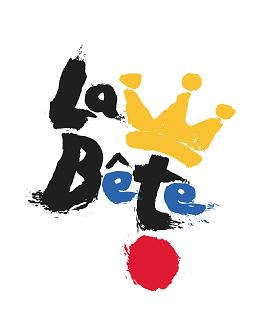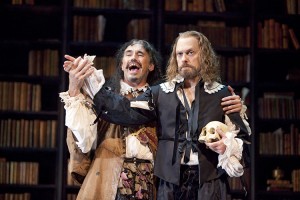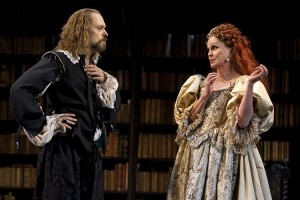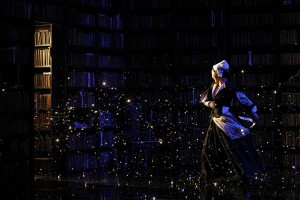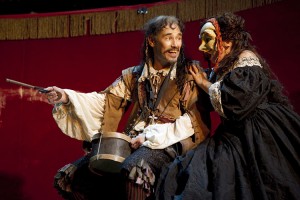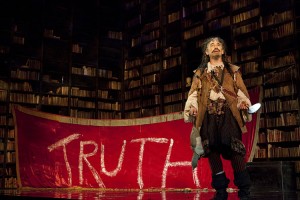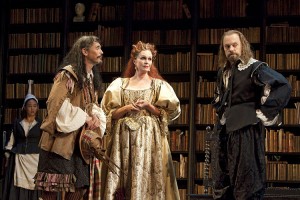A LEGENDARY PLAY’S
SECOND CHANCE AT BROADWAY LIFE
Were David Hirson’s La Bête not burdened with history, this review would simply say that Matthew Warchus’s production includes Mark Rylance’s tour de force performance of an immensely entertaining half-hour-long monologue and solid comic performances by David Hyde Pierce and Stephen Ouimette, but is one-note and overlong, fails to live up to its pretensions, and (unless Hirson is deliberately attacking his own play) is guilty of precisely what it criticizes. Nonetheless, despite its flaws, the show is, on the whole, fun. But La Bête is a minor legend among theater cognoscenti, and, therefore, those with better things to do than obsess about theater are entitled to a synopsis of its history.
The 1991 Broadway premiere of La Bête was hailed by critics as daring because it is written entirely in rhymed verse and was given a highly stylized production by director Richard Jones. The production also involved an understudy fairytale. The late well-known actor Ron Silver was originally cast as the boorish street clown Valere (currently played by Rylance), but, just as pre-Broadway out of town performances were beginning, he left the production due to “creative differences.” His role was taken over not by another name actor, but by his understudy Tom McGowan, who went on to receive a Tony nomination for best actor. Though he acknowledged the boldness of the production, then New York Times theater critic Frank Rich wrote that the script ultimately failed, and La Bête closed after 25 performances. Yet, La Bête has its partisans, who feel that Rich was unfair, and that the show deserved another chance – which it is now getting.
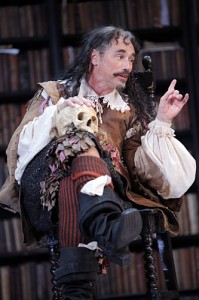 I never had an opinion about the controversy, not having seen the original production. Now I do. Surprisingly, Frank Rich, who adored bland pop operas like Les Miserables and raved about the intellectually ambitious but (in this reviewer’s opinion) ultimately shallow Angels in America, was right. He wrote, “one won’t soon forget the first half-hour or so of La Bête, which takes the brave chances so rare in new American plays … Yet the follow-through is almost nonexistent.”
I never had an opinion about the controversy, not having seen the original production. Now I do. Surprisingly, Frank Rich, who adored bland pop operas like Les Miserables and raved about the intellectually ambitious but (in this reviewer’s opinion) ultimately shallow Angels in America, was right. He wrote, “one won’t soon forget the first half-hour or so of La Bête, which takes the brave chances so rare in new American plays … Yet the follow-through is almost nonexistent.”
In the play, a member of the French royal family (“Prince Conti” in the original production and Joanna Lumley’s nameless “Princess” in the current revival) has commanded Elomire (which, as every review will tell you, is anagram of “Moliere”), the leader of a theater troupe under the Princess’s patronage, to meet Valere and invite him into the company. A man of high artistic standards, Elomire (Hyde Pierce) is adamantly opposed to doing so. Valere’s near endless speech is an aria of boorishness, self-love, pretension, and ignorance, punctuated by farts and defecation. From the end of this soliloquy until the Princess’s entrance Elomire lambasts Valere, who responds with more grossness and stupidity, which had been enjoyable during the speech, but now become tiresome. This, indeed, is non-existent follow-through.
Toward the end of the play, Valere and the actors from Elomire’s company perform a crude parable of Valere’s that, surprisingly, decries the triumph of mediocrity over excellence. Hirson may reconcile this seeming paradox of a popular low-brow entertainer who attacks the popularity of low-brow entertainment when he has Elomire say that crass panderers appropriate the language of art.
It does not take Elomire’s intellect to conclude that La Bête, itself, is just a more sophisticated version of Valere’s little play: it skewers vulgarity and defends high art while setting its audience roaring with fart and feces jokes (n.b. I love a good fart joke as much as the next guy). Rich took Hirson to task for this: “There is not a single idea or debate in this play aside from its cost-free endorsement of excellence over trash, and even that one conviction is conveyed not through theatrical excellence but by a sermon that implicitly flatters the audience for its own elevated taste and for its cultural superiority to the riff-raff presumably watching those Broadway shows written in lowly prose.” However, the obviousness of this parallel raises the question of whether Hirson is aware that his play is no different from Valere’s. If so, is he siding with Valere over the aesthetically puritanical Elomire? (As Michael Feingold points out in his review, Moliere was not such a purist as Elomire.) Is he throwing up his hands and saying, “This is the only way I can get my message across?” Or is the not terribly profound argument of the play merely an excuse for writing flatulence and feces jokes in rhymed verse?
The rhymed verse is comically effective. Because of the rhyme, the audience can anticipate the punch lines of some the jokes based on the sounds of the last words of the set-ups. This anticipation makes the punch lines all the more funny. However, this is neither the bold stroke nor the daunting feat that some critics make it out to be: it is a fun, but not terribly difficult, writing exercise.
Rylance is hysterically funny and charming and brilliantly carries off Valere’s talkathon. Hyde Pierce makes an excellent straight man, staring at the babbling boor with stunned blankness and dryly tossing off his barbs. Hyde Pierce frequently used this understated delivery in Frasier, but it’s hard to fault him for bringing out this well-worn schtick, since it suits his character so well. Stephen Ouimette as a senior member of Elomire’s company is as adept at deadpan as Hyde Pierce. The one disappointing performance is given by Lumley, who shouts many of her lines. She does have a funny moment, though, when she quietly but insistently repeats “savant” every time Elomire calls Valere an “idiot” or a “chucklehead.”
Matthew Warchus has presided over a funny and entertaining production. However, he employs three ostentatious special effects that are out of synch with rest of the production and, far too cutely, has the Princess join audience members in a side box when she watches Valere’s play.
Warchus’s directorial flourishes are not the only inconsistencies. Hirson has written in a maid (Greta Lee) who can only speak in monosyllables containing the diphthong “oo” (“blue,” “shoe,” etc.). She seems to have entered from a different and very irritating play.
Mark Thompson’s set, made up of towering bookcases that contain camouflaged doors, is stunning, and his costumes are handsome. The one misstep in the design is the Princess’s wig, which makes her look less like 17th-century French royalty and more like Lanie Kazan with henna in her hair and her finger in an electrical socket.
Despite the fact that it runs out of steam, and that its central idea is far from profound and possibly hypocritical, La Bête’s funny moments outnumber its tiresome stretches (and those funny moments are very funny indeed), and the skilled comic performances of Rylance, Hyde Pierce, and Ouimette are pure pleasure to behold.
photos by Manuel Harlan
La Bête
Music Box Theatre
ends on January 9, 2011
for tickets, visit La Bete The Play
